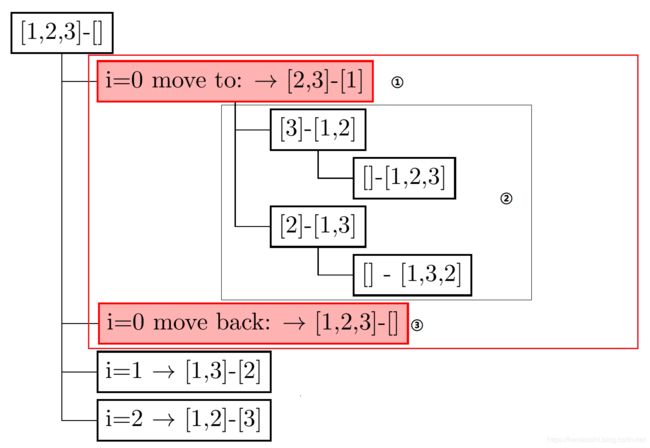数组全排列问题详解
问题
给定一个集合 S S S,输出集合元素的全排列,例如,当 S S S=(1,2,3)时,全排列为(1,2,3), (1,3,2), (2,1,3), (2,3,1), (3,1,2), and (3,2,1).
分析与设计
全排列问题是求一个集合中所有元素不重复的排列结合,因此属于穷举法问题。但是问题的关键是如何不重复的进行列举。实际上,此问题我们可以理解为一个树的遍历问题。如下图所示,对于集合[1,2,3],可以建立以下的树。

对于只有3个元素的集合,生成的全排列树的第一级有3种可能,第二级是2种,第三级是1种。所以,对于数量为 n n n 的集合,树的总节点数是 n ! n! n! 。通过附录算法1,我们可以构建这样的树。
当树完成以后,再利用树的遍历进行一次完全遍历,记录路径信息,则每一个单独的路径上的值的序列即是一个不重复的排列,所有路径的集合即是数组的全排列。
我们可以用一个输入列表 inList 表示输入数据,然后对所有的可能抽取位置,每次从中取一个元素追加到另一个辅助列表 auxList 末尾。如果 inList 不为空,则继续递归计算;否则,在 auxList 中则为排列结合。抽取测试完一种情况后,再将这个元素返回。为一更好地了解整个过程,可以以树型表示,如下图所示。

注:以上绘制代码可以在找到 Latex学习笔记 (Ex2) 使用LaTeX画规则的树形图.
在图中所示,对初始化数组 inList 和 auxList 以中括号表示,使用横杠连接。在红色方框内,为 i = 0,即对1个元素进行操作的情况。这时,有三步操作:
- ① 移动第0个元素,可以得到
[2,3] - [1] - ② 对新的组合调用遍历,这时有两种情况分别是
[1,2,3]和[1,3,2]进行输出 - ③ 将第1个元素移回,以方便下一步(即 i = 1) 的操作。
这样通过递归遍历,即可实现对数据的全排列输出。
实现代码
/**
* 使用递归输出 inList 中的元素的全排列,auxList为辅助数据。
* @param inList 输入列表。
* @param auxList 辅助列表。
*/
static void traverse(ArrayList<Integer> inList, ArrayList<Integer> auxList) {
if (inList.size() > 0) { // inList 中有元素,元素递归没有结束,继续递归。
for (int i = 0; i < inList.size(); i++) {
auxList.add(inList.remove(i)); // 将 inList 中第 i 个元素添加至 auxList 末尾
traverse(inList, auxList); // 递归调用变化后的数组情况
inList.add(i, auxList.remove(auxList.size() - 1)); // 再将这个元素归还给 inList.
}
} else { // inList 中元素为空,表示已经全部排列,输出结果。
System.out.println(Arrays.toString(auxList.toArray()));
}
}
测试
测试代码:
traverse(new ArrayList
结果:
[1, 2, 3, 4]
[1, 2, 4, 3]
[1, 3, 2, 4]
[1, 3, 4, 2]
[1, 4, 2, 3]
[1, 4, 3, 2]
[2, 1, 3, 4]
[2, 1, 4, 3]
[2, 3, 1, 4]
[2, 3, 4, 1]
[2, 4, 1, 3]
[2, 4, 3, 1]
[3, 1, 2, 4]
[3, 1, 4, 2]
[3, 2, 1, 4]
[3, 2, 4, 1]
[3, 4, 1, 2]
[3, 4, 2, 1]
[4, 1, 2, 3]
[4, 1, 3, 2]
[4, 2, 1, 3]
[4, 2, 3, 1]
[4, 3, 1, 2]
[4, 3, 2, 1]
附1:完全树的生成算法
import java.util.ArrayList;
import java.util.List;
import java.util.Stack;
public class Node {
public static void main(String[] args) {
Node root = Node.createTree(new int[]{1,2,3});
System.out.println(root);
}
//
public Node parent;
public int data;
public List<Node> nodes = new ArrayList<Node>();
public int[] values = new int[0];
public static Node createTree(int[] array) {
Node root = new Node();
root.values = array;
Stack<Node> stack = new Stack<Node>();
stack.push(root);
while (stack.size() > 0) {
Node node = stack.pop();
for (int i = 0; i < node.values.length; i++) {
Node child = new Node();
child.data = node.values[i];
child.parent = node;
child.values = new int[node.values.length - 1];
for (int j = 0; j < child.values.length; j++)
child.values[j] = node.values[j < i ? j : j + 1];
node.nodes.add(child);
stack.push(child);
}
}
return root;
}
}